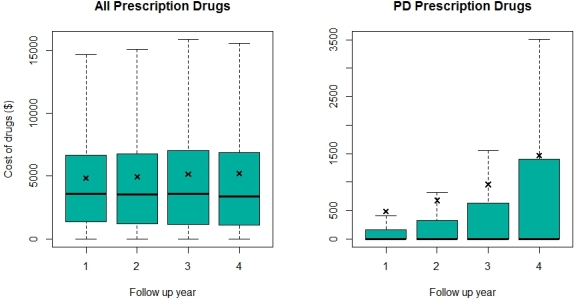Session Information
Date: Thursday, June 23, 2016
Session Title: Parkinson's disease: Clinical trials, pharmacology and treatment
Session Time: 12:00pm-1:30pm
Location: Exhibit Hall located in Hall B, Level 2
Objective: Evaluate healthcare costs for a cross-section of patients with Parkinson’s disease (PD).
Background: PD is a progressive, nonfatal condition with an increasing societal cost burden. Prescription drugs are the main therapy used to manage symptoms, but they become less effective and may lead to side effects at increased doses as the disease progresses.
Methods: The Truven Health MarketScan™ databases of patients with private and Medicare insurance from April 2009 to March 2014 were used to study a broad population of PD patients. The index event was defined as the first occurrence of a PD diagnosis code (332.0). Patients were included if they had at least 2 years of continuous coverage post-PD diagnosis and were at least 18 years of age. Outcome variables were annual medical and pharmaceutical cost over a follow up period of 2-5 years. Analysis of covariance, with adjustment for age and gender, was used to analyze changes in healthcare utilization over time.
Results: A total of 68,542 patients (mean age 71±12 years at the index event; 57% male) met the study inclusion criteria. The average follow up time was 3.3±0.9 years. During the first year of follow up, average healthcare expenditures were $5,151±5,670 for all prescription drugs, $11,933±33,586 for hospitalizations, and $11,404±21,801 for outpatient medical expenditures. Within the study period, there were no significant increases in overall medical or pharmaceutical expenditures. Prescription drug costs related to management of Parkinsonian symptoms were on average $481±1,650 during the first year and increased by $194±2,761 during the 2nd year of follow up (p<0.001). The increase in cost over time of Parkinsonian prescriptions was correlated with the duration of the follow up period, with cost increasing by $278±3,708 from year 2-3 and by $566±6,105 from year 3-4 (Figure).
Conclusions: In a cross section of PD patients, there is a sizeable direct cost burden associated with prescription drugs, hospitalizations, and outpatient expenditures. While per-patient cost for all expenditures remained steady over the follow-up period, the cost for Parkinsonian-specific prescriptions accelerated. There is a need for additional therapies to manage or slow the progression of PD symptoms.  Boxplots show median (line), quartiles (box) and mean (x) prescription drug cost per patient in each year of follow up. Plots show total cost for all prescription drugs (left) and only PD-related drugs (right).
Boxplots show median (line), quartiles (box) and mean (x) prescription drug cost per patient in each year of follow up. Plots show total cost for all prescription drugs (left) and only PD-related drugs (right).
To cite this abstract in AMA style:
M. Tagliati, A.T. Connolly. Healthcare burden of Parkinson’s disease [abstract]. Mov Disord. 2016; 31 (suppl 2). https://www.mdsabstracts.org/abstract/healthcare-burden-of-parkinsons-disease/. Accessed December 29, 2025.« Back to 2016 International Congress
MDS Abstracts - https://www.mdsabstracts.org/abstract/healthcare-burden-of-parkinsons-disease/
